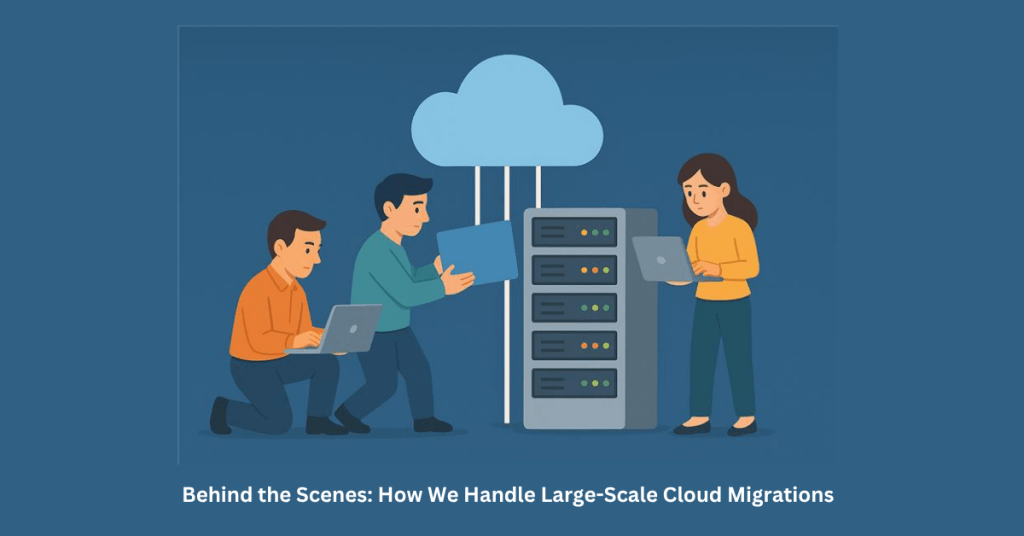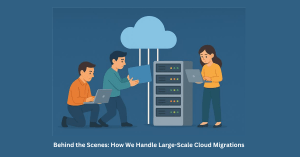Large-scale cloud migration is a structured process that involves assessment, planning, architecture design, data transfer, application modernization, testing, and final cutover. At 24x7ServerManagement, we use automation, DevOps pipelines, zero-downtime strategies, and multi-region best practices to ensure smooth and secure migrations for enterprises in India, UAE, and global markets.
Behind the Scenes: How We Handle Large-Scale Cloud Migrations
Migrating an entire business ecosystem to the cloud is a high-stakes, high-impact transformation. For enterprises, fintech companies, e-commerce brands, and SaaS startups, the cloud is no longer optional — it’s the operational backbone of agility, scalability, and security.
At 24x7ServerManagement, we specialize in large-scale cloud migrations across AWS, Azure, Google Cloud, and hybrid infrastructures. But what really happens behind the scenes? How do we ensure that mission-critical workloads, databases, applications, and services move safely — without breaking anything?
This blog pulls back the curtain and walks you through our end-to-end cloud migration framework, optimized for accuracy, zero downtime, global performance, and future-proof scalability.
Why Large-Scale Cloud Migration Matters
Large-scale migration isn’t just about “moving servers.” It’s about enabling businesses to innovate, reduce costs, and eliminate infrastructure limitations.
Common reasons companies migrate to the cloud:
- High on-premise maintenance and hardware refresh costs
- Need for greater elasticity and auto-scaling
- Compliance mandates (PCI DSS, GDPR, ISO 27001)
- Better performance and disaster recovery
- Global expansion (India, UAE, USA, Europe, APAC)
What Is a Large-Scale Cloud Migration?
A large-scale cloud migration refers to transferring hundreds of servers, terabytes of data, multiple applications, and entire business workflows to the cloud — all while ensuring performance, security, and business continuity.
Includes:
- Application servers
- Databases
- APIs & microservices
- Containers & Kubernetes clusters
- Big data workloads
- Network, IAM, storage systems
How We Plan Enterprise-Grade Cloud Migrations
Before touching a single server, we build a high-accuracy blueprint to guarantee a risk-free migration.
Step 1 — Deep Infrastructure Assessment
We analyze:
- Server inventory
- Application dependencies
- Database size & complexity
- Network & firewall structure
- Compliance and security requirements
- Peak traffic behavior
Tools we use:
Azure Migrate, AWS Migration Hub, Kubernetes Discovery, Grafana, Prometheus, custom audit tools.
This assessment helps us identify quick wins, risks, modernization opportunities, and cost-saving strategies.
Step 2 — Migration Strategy & Roadmap
Every business is unique, so we design a tailored strategy using one of the proven migration models:
The 6R Strategy
- Rehost (Lift & Shift)
- Replatform
- Repurchase
- Refactor / Re-architect
- Retain
- Retire
For large enterprises, we commonly use a combination of Rehost + Refactor, ensuring the best balance between cost and modernization.
Step 3 — Architecture Design (Cloud + DevOps + Security)
We design a high-availability, multi-zone, auto-scaling architecture to ensure cloud performance across India, UAE, and international regions.
Our architecture includes:
- Multi-AZ & Multi-Region setups
- Kubernetes / EKS / AKS clusters
- Auto-scaling groups
- Managed databases
- Load balancers & API gateways
- Secure VPC design
- WAF, anti-DDoS, IAM best practices
- Backup, DR, RPO/RTO planning
How We Execute Large-Scale Cloud Migrations (Behind the Scenes)
This is where the real magic happens.
Step 4 — Preparing the Landing Zone
We set up:
- Virtual networks
- Firewall rules
- IAM roles & policies
- Monitoring & observability
- Logging pipelines
- Cost control policies
- Kubernetes clusters
This ensures the new environment is secure, scalable, and production-ready.
Step 5 — Data Migration (Zero Data Loss Strategy)
For mission-critical workloads, data loss is non-negotiable.
We use:
- Database replication
- Log shipping
- Storage snapshot transfers
- Real-time sync tools (DMS, RAC, AlwaysOn, etc.)
We often run dual-write or read replicas before the final switch to ensure complete accuracy.
Step 6 — Application Migration
Application migration depends on the architecture:
Lift & Shift
Perfect for legacy applications needing rapid relocation.
Containerization
We modernize workloads into Docker containers + Kubernetes clusters.
Microservices
We break monolithic systems into scalable microservices (a common trend in fintech & SaaS sectors).
Step 7 — Testing, Validation & Tuning
No migration becomes “production-ready” without intense testing.
We verify:
- Load & stress performance
- API health
- Database query speed
- Session handling
- Auto-scaling behavior
- Failover testing
- Security & compliance
Real-world example:
One UAE-based e-commerce client saw a 40% reduction in load time and 99.99% uptime after our post-migration optimization.
Step 8 — Cutover (The Final Switch)
This is the moment everything becomes real.
We perform:
- DNS switch with global propagation
- Traffic draining
- Final sync
- Go-live verification
Our goal: Zero downtime or minimal downtime in off-peak hours.
Step 9 — Post-Migration Optimization & 24×7 Monitoring
Even after migration, our job continues.
We ensure:
- Cost optimization
- Performance tuning
- Security hardening
- 24×7 monitoring & alerting
- Backup verification
- DR drill testing
This ongoing support makes migrations future-proof.
Why Enterprises Choose Us for Cloud Migration
Because we deliver:
- ✔ Zero-downtime migrations
- ✔ PCI DSS, HIPAA, GDPR compliant processes
- ✔ Experience across fintech, healthcare, travel, SaaS
- ✔ India + UAE + Global deployment experience
- ✔ Deep expertise in AWS, Azure, Kubernetes, DevOps
- ✔ End-to-end consulting + execution + 24×7 support
Real-World Example: Large-Scale Migration Success Story
A leading fintech customer in the Middle East migrated:
- 150+ servers
- 30+ microservices
- 8 TB database
- PCI-compliant workloads
We created:
- Multi-region Azure architecture
- Kubernetes-based workloads
- Zero downtime data replication
- Automated CI/CD pipelines
Result:
✔ 55% improvement in application response time
✔ 47% reduction in infrastructure cost
✔ 100% compliance with audits
What Makes Our Cloud Migration Approach Unique?
1. Automation First
CI/CD, Infrastructure as Code, automated testing, monitoring, alerting.
2. Zero-Downtime Philosophy
We ensure business continuity at all times.
3. Cross-Region Expertise
We design architectures for India, UAE, US, Singapore, and Europe.
4. Security-Driven Approach
Security is baked into every stage — not added later.
5. 24×7 Support
Our NOC and cloud teams operate round the clock.
Conclusion: Your Cloud Migration, Handled with Precision
Large-scale cloud migration is complex — but with the right team, it becomes a strategic advantage. At 24x7ServerManagement, we bring years of expertise in DevOps, Kubernetes, cloud consulting, and large-scale migrations for enterprises across India, UAE, and global markets.
If you’re planning a migration — or struggling with one — we’re ready to help you move smoothly, securely, and efficiently.
Want to migrate your workloads without downtime, risk, or surprises?
Contact us today for a free cloud migration assessment.
Visit: 24x7servermanagement.com
Frequently Asked Questions
1. What is large-scale cloud migration?
It involves moving entire enterprise workloads — applications, servers, databases, and networks — to the cloud with a structured and secure strategy.
2. How do you ensure zero downtime during migration?
We use replication, load balancing, traffic shifting, and parallel environments to perform seamless cutovers without affecting customers.
3. What tools are used for cloud migration?
Azure Migrate, AWS Migration Hub, Kubernetes tools, CI/CD pipelines, monitoring systems, and data migration tools like DMS.
4. Which industries benefit from cloud migration?
Fintech, healthcare, SaaS, logistics, e-commerce, manufacturing, and government sectors gain cost, scalability, and performance advantages.






